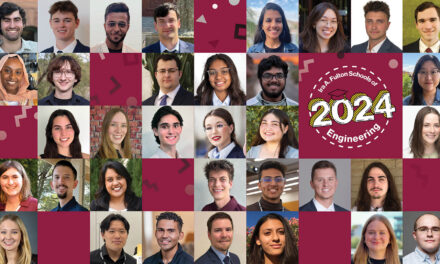
Power to the people
Fulton Schools energy experts drive new initiatives for global good

Almost 760 million people live without electricity. The United Nations identifies this lack of energy access as a fundamental barrier to progress in terms of human health, food security, education, gender equality and other measures of development.
Broader provision of affordable, reliable, clean energy is therefore a key aspect of the UN’s global plan for eradicating poverty in tandem with efforts to tackle climate change and environmental conservation. Making this happen will require what the UN calls transformational collaborations among governments, industries and other stakeholders.
Higher education occupies a pivotal position in partnerships to change the energy landscape, and multiple faculty members in the Ira A. Fulton Schools of Engineering at Arizona State University are driving new global initiatives.
“Every additional electrical connection and renewables expansion is a victory for people and the planet,” says Nathan Johnson, an associate professor of engineering in the Fulton Schools and director of the Laboratory for Energy And Power Solutions, or LEAPS.
“But grid systems in emerging markets may be in disrepair, cause heavy pollution and provide poor power quality. Further, the significant debt that burdens many electric utilities limits their choices to modernize,” he says. “These challenges require an in-depth understanding of the problem space and partnerships that drive innovation across multiple dimensions to facilitate utilities becoming self-reliant.”
Johnson serves as a member of the board of directors for the United States Energy Association, or USEA, which supports the expansion and improvement of energy access globally. This complex work encompasses technological, commercial, institutional, financial, policy and workforce aspects of development.
With the goal of supporting more meaningful and sustainable change on all of these fronts, USEA, ASU and three other partner organizations have formed a new consortium. Advancing Modern Power through Utility Partnerships, or AmpUp, has been funded for five years with $39 million from the United States Agency for International Development, or USAID.
Johnson says AmpUp will have global reach and operate at a national level, coordinating with USAID mission offices and electric utilities in each participating country. The consortium member organizations will work alongside relevant stakeholders in a given nation-state to conduct a gap analysis of the energy sector, and then deploy a tailored set of assistance programs to fit local need.
Within these offerings, ASU will lead modular training in technical, business, policy, environmental and social aspects of grid modernization for industry executives, government regulators, engineers and operators. The university will also lead the provision of workforce development sessions focused on creating a pipeline of new energy sector talent, particularly among women.
Johnson says research, development and demonstration are embedded within AmpUp to facilitate learning and adaptation to enhance local impact and the ability to scale globally in the context of a rapidly evolving energy sector.
“This effort has the potential to benefit millions of people across more than a dozen countries,” he says. “It’s very needs-focused and a powerful example of the ASU charter at work on a global stage.”
Promoting change in the context of culture
Fulton Schools faculty members have a powerful track record for international energy sector impact. Sayfe Kiaei, a professor of electrical engineering, directed the U.S.-Pakistan Centers for Advanced Studies in Energy, or USPCAS-E, from 2014 to 2019. This USAID-funded project significantly advanced regional energy sector research and education through ASU’s collaboration with two Pakistani universities and a range of industry and government stakeholders.
“We developed new graduate degree programs, hosted hundreds of exchange visits for faculty and students, conducted dozens of applied research projects and fostered many public-private partnerships over the course of that effort,” Kiaei says.
“We also learned that some of the most complex issues are not technical, but cultural. Any efforts to advance energy sector education, operations or governance need to be approached with awareness of, and respect for, regional context,” he says.
Kiaei is now applying his international expertise and experience to direct a Center of Excellence for Energy, or COE/E, in Egypt. With USAID funding of more than $22 million, ASU will be leading a collaboration with three Egyptian universities over five years.
This COE/E will work to strengthen the capacity of Egyptian higher education to deliver relevant applied research, produce graduates to meet the evolving needs of industry and engage government stakeholders in dialogue to advance evidence-based policymaking for the energy sector.
Kiaei says new research is particularly important. He expects as much as one quarter of the project funding will support 15 projects each year, targeting issues that Egyptian government authorities and energy utilities identify as most important. These efforts will simultaneously enable newly equipped laboratory facilities and the application of more innovative curriculum and experiential learning.
“We have a great opportunity to expand Egyptian capabilities to address current energy sector needs and those in the decades ahead,” he says. “We also hope to equip educators, engineers, policymakers and others to become workforce developers in Egypt as well as across the broader eastern Mediterranean and Persian Gulf region.”
Defending gains in the context of threat
Research to improve global energy access must also address security measures. Modern power grids are cyberphysical systems comprising both data infrastructure and networks of electrical hardware. So, the new technology that automates and optimizes power transmission and distribution also comes with greater vulnerability to accidental disruptions and malicious threats.
Yang Weng, an assistant professor of electrical engineering in the Fulton Schools, is applying his expertise in this field to direct ASU’s leadership of a new international consortium with support from Ben-Gurion University of the Negev. The effort coordinates nearly two dozen other research institutions, power utilities and private companies in developing new technologies to solve critical energy sector cybersecurity challenges.
Known as the Israel-U.S. Initiative on Cybersecurity Research and Development for Energy, or ICRDE, it will operate as part of the U.S.-Israel Energy Center, an energy security and economic development initiative of the U.S. Department of Energy, the Israel Ministry of Energy and Israel Innovation Authority. ICRDE will be funded by $12 million, with $6 million of cost sharing, and operate for three years alongside peer consortia devoted to address other international energy and water priorities.
Weng says ICRDE will deliver projects across three main themes. The first will model the cyberphysical systems of energy networks and establish a comprehensive database of current knowledge about cyberattacks.
Theme two will develop advanced tools to monitor both energy system information technology, or data flow, and operational technology, which is physical equipment. The final theme will design control tools to “futureproof” energy system architecture with necessary resilience and robustness.
“Our goal is to establish a fundamental understanding of how to best defend these vital systems,” Weng says. “At the same time, we would like to commercialize products so the impact of this work can be applied immediately. Finally, we would like to build principles for effective cybersecurity analysis and solutions for today’s and tomorrow’s needs.”
He adds, “We have an impressive history of investment in artificial intelligence and cybersecurity at the Fulton Schools. That’s also the case for energy systems; our power program is recognized globally. So, we have significant opportunities to apply expertise and resources with meaningful global effect.”



































